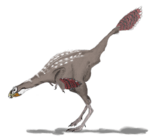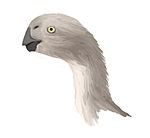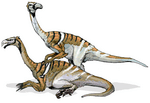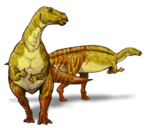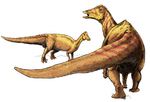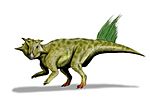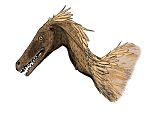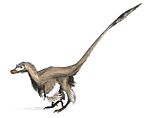List of Asian dinosaurs facts for kids
This is a list of dinosaurs whose remains have been found in Asia, other than India. During the Mesozoic, India was not part of Asia. It was part of the supercontinent Gondwana, and then a separate island. More dinosaurs have been found in Asia than any other continent so far.
-
Name Period Diet Notes Abrosaurus Jurassic herbivore A Small sauropod that looked a lot like Camarasaurus. Achillobator Cretaceous carnivore — Adasaurus Cretaceous carnivore — Agilisaurus Jurassic herbivore — Airakoraptor Cretaceous carnivore — Albalophosaurus Cretaceous herbivore — Alectrosaurus Cretaceous carnivore — Alioramus Cretaceous carnivore — Altirhinus Cretaceous herbivore — Alxasaurus Cretaceous carnivore — Amtosaurus Cretaceous herbivore Based only on fragments of its skull. Amurosaurus Cretaceous herbivore — Anchiornis Jurassic carnivore Smallest known dinosaur that is not a bird. Anserimimus Cretaceous omnivore — Aralosaurus Cretaceous herbivore — Archaeoceratops Cretaceous herbivore — Archaeornithoides Cretaceous carnivore — Archaeornithomimus Cretaceous omnivore — Arkharavia Cretaceous omnivore — Arstanosaurus Cretaceous herbivore — Asiaceratops Cretaceous herbivore — Asiatosaurus Cretaceous herbivore — Auroraceratops Cretaceous herbivore — Avimimus Cretaceous omnivore — Bactrosaurus Cretaceous herbivore — Bagaceratops Cretaceous herbivore — Bagaraatan Cretaceous carnivore — Bainoceratops Cretaceous herbivore — Bakesaurus Cretaceous (unknown) Uncertain, see article Balochisaurus Cretaceous herbivore — Banji Cretaceous (unknown) — Baotianmansaurus Cretaceous herbivore — Barsboldia Cretaceous herbivore — Beipiaosaurus Cretaceous carnivore — Beishanlong Cretaceous omnivore — Bellusaurus Jurassic herbivore — Bienosaurus Jurassic herbivore — Bissektipelta Cretaceous herbivore — Bolong Cretaceous herbivore — Borealosaurus Cretaceous herbivore — Borogovia Cretaceous carnivore — Breviceratops Cretaceous herbivore — Brohisaurus Jurassic herbivore — Byronosaurus Cretaceous carnivore — Caenagnathasia Cretaceous omnivore — Caudipteryx Cretaceous omnivore — Ceratonykus Cretaceous omnivore — Changchunsaurus Cretaceous herbivore — Changdusaurus Jurassic herbivore — Chaoyangsaurus Jurassic herbivore — Charonosaurus Cretaceous herbivore — Chialingosaurus Jurassic herbivore — Chiayusaurus Jurassic herbivore — Chilantaisaurus Cretaceous carnivore — Chingkankousaurus Cretaceous carnivore — Chinshakiangosaurus Jurassic herbivore — Chuandongocoelurus Jurassic carnivore — Chuanjiesaurus Jurassic herbivore — Chungkingosaurus Jurassic herbivore — Citipati Cretaceous omnivore — Conchoraptor Cretaceous carnivore — Crichtonsaurus Cretaceous herbivore — Cryptovolans Cretaceous carnivore — Daanosaurus Jurassic herbivore — Dachongosaurus Jurassic herbivore — Damalasaurus Jurassic herbivore — Dashanpusaurus Jurassic herbivore — Datousaurus Jurassic herbivore — Daxiatitan Cretaceous herbivore — Deinocheirus Cretaceous herbivore Largest known ornithomimisaur. Dilong Cretaceous carnivore — Dilophosaurus Jurassic carnivore — Dongbeititan Cretaceous herbivore — Dongyangosaurus Cretaceous herbivore — Elmisaurus Cretaceous carnivore — Enigmosaurus Cretaceous herbivore — Eomamenchisaurus Jurassic herbivore — Epidendrosaurus Jurassic carnivore See article Epidexipteryx Jurassic carnivore — Equijubus Cretaceous herbivore — Erketu Cretaceous herbivore — Erliansaurus Cretaceous herbivore — Erlikosaurus Cretaceous herbivore — Eshanosaurus Jurassic herbivore — Eugongbusaurus Jurassic herbivore — Euhelopus Cretaceous herbivore — Ferganasaurus Jurassic herbivore — Ferganocephale Jurassic herbivore — Fukuiraptor Cretaceous carnivore — Fukuisaurus Cretaceous herbivore — Fukuititan Cretaceous herbivore — Fulengia Jurassic herbivore — Fusuisaurus Cretaceous herbivore — Futabasaurus Cretaceous carnivore Name not published officially and later used for a plesiosaur Gadolosaurus Cretaceous herbivore — Gallimimus Cretaceous omnivore — Garudimimus Cretaceous omnivore — Gasosaurus Jurassic carnivore — Gigantoraptor Cretaceous omnivore — Gigantspinosaurus Jurassic herbivore — Gilmoreosaurus Cretaceous herbivore — Gobiceratops Cretaceous herbivore — Gobisaurus Cretaceous herbivore — Gobititan Cretaceous herbivore — Gongbusaurus Jurassic herbivore — Gongxianosaurus Jurassic herbivore — Goyocephale Cretaceous herbivore/omnivore — Graciliceratops Cretaceous herbivore — Graciliraptor Cretaceous carnivore — Guanlong Jurassic carnivore — Gyposaurus Jurassic herbivore — Hanwulosaurus Cretaceous herbivore — Haplocheirus Jurassic carnivore — Harpymimus Cretaceous herbivore — Heilongjiangosaurus Cretaceous herbivore — Heishansaurus Cretaceous herbivore — Helioceratops Cretaceous herbivore — Hexinlusaurus Jurassic herbivore — Heyuannia Cretaceous carnivore — Hironosaurus Cretaceous herbivore — Hisanohamasaurus Cretaceous herbivore — Homalocephale Cretaceous herbivore/omnivore — Hongshanosaurus Cretaceous herbivore — Huabeisaurus Cretaceous herbivore — Huanghetitan Cretaceous herbivore — Huaxiagnathus Cretaceous carnivore — Huayangosaurus Jurassic herbivore — Hudiesaurus Jurassic herbivore — Hulsanpes Cretaceous carnivore — Incisivosaurus Cretaceous herbivore/omnivore — Ingenia Cretaceous (unknown) — Isanosaurus Triassic herbivore A very early dinosaur Itemirus Cretaceous carnivore — Jaxartosaurus Cretaceous herbivore — Jeholosaurus Cretaceous herbivore — Jiangjunosaurus Jurassic herbivore — Jiangshanosaurus Cretaceous herbivore — Jinfengopteryx Jurassic/Cretaceous omnivore — Jingshanosaurus Jurassic herbivore — Jintasaurus Cretaceous herbivore — Jinzhousaurus Cretaceous herbivore — Jiutaisaurus Cretaceous herbivore — Kagasaurus Cretaceous (unknown) — Kaijiangosaurus Jurassic carnivore — Katsuyamasaurus Cretaceous carnivore — Kelmayisaurus Cretaceous carnivore — Kerberosaurus Cretaceous herbivore — Khaan Cretaceous carnivore/omnivore — Khetranisaurus Cretaceous herbivore — Kileskus Jurassic carnivore — Kinnareemimus Cretaceous omnivore — Klamelisaurus Jurassic herbivore — Kol Cretaceous carnivore — Koreanosaurus Cretaceous herbivore — Kulceratops Cretaceous herbivore — Kunmingosaurus Jurassic herbivore — Kuszholia Cretaceous (unknown) — Lamaceratops Cretaceous herbivore — Lancanjiangosaurus Jurassic herbivore — Lanzhousaurus Cretaceous herbivore — Leshansaurus Jurassic carnivore — Levnesovia Cretaceous herbivore — Liaoceratops Cretaceous herbivore — Liaoningosaurus Cretaceous herbivore Smallest known ankylosaur Limusaurus Jurassic herbivore — Linheraptor Cretaceous carnivore — Luanchuanraptor Cretaceous carnivore — Lufengosaurus Jurassic herbivore — Lukousaurus Jurassic carnivore Possibly a crocodilian rather than a dinosaur Luoyanggia Cretaceous (unknown) — Machairasaurus Cretaceous omnivore — Magnirostris Cretaceous herbivore — Mahakala Cretaceous carnivore — Maleevus Cretaceous herbivore — Mamenchisaurus Jurassic herbivore — Mandschurosaurus Cretaceous herbivore — Marisaurus Cretaceous herbivore — Megacervixosaurus Cretaceous herbivore — Mei Cretaceous carnivore — Microceratus Cretaceous herbivore — Microdontosaurus (unknown) herbivore Dating dubious Microhadrosaurus Cretaceous herbivore — Micropachycephalosaurus Cretaceous herbivore — Microraptor Cretaceous carnivore — Mifunesaurus Cretaceous carnivore — Minotaurasaurus Cretaceous herbivore — Mongolosaurus Cretaceous herbivore — Monkonosaurus Jurassic herbivore — Monolophosaurus Jurassic carnivore — Mononykus Cretaceous carnivore — Nanningosaurus Cretaceous herbivore — Nanshiungosaurus Cretaceous carnivore — Nanyangosaurus Cretaceous herbivore — Neimongosaurus Cretaceous herbivore — Nemegtomaia Cretaceous carnivore/omnivore — Nemegtosaurus Cretaceous herbivore — Ngexisaurus Jurassic carnivore — Nipponosaurus Cretaceous herbivore — Nomingia Cretaceous carnivore/omnivore — Nurosaurus Cretaceous herbivore — Olorotitan Cretaceous herbivore — Omeisaurus Jurassic herbivore — Opisthocoelicaudia Cretaceous herbivore — Oshanosaurus Jurassic herbivore — Otogosaurus Cretaceous herbivore — Oviraptor Cretaceous omnivore — Pakisaurus Cretaceous herbivore — Parvicursor Cretaceous (unknown) — Pedopenna Jurassic (unknown) — Peishansaurus Cretaceous herbivore — Penelopognathus Cretaceous herbivore — Phaedrolosaurus Cretaceous carnivore — Phuwiangosaurus Cretaceous herbivore — Pinacosaurus Cretaceous herbivore — Platyceratops Cretaceous herbivore — Prenocephale Cretaceous herbivore/omnivore — Probactrosaurus Cretaceous herbivore — Prodeinodon Cretaceous carnivore Dubious, see article Protarchaeopteryx Cretaceous herbivore/omnivore — Protoceratops Cretaceous herbivore — Protognathosaurus Jurassic herbivore — Psittacosaurus Cretaceous herbivore — Pukyongosaurus Cretaceous herbivore — Qiaowanlong Cretaceous herbivore — Qingxiusaurus Cretaceous herbivore — Qinlingosaurus Cretaceous herbivore — Quaesitosaurus Cretaceous herbivore — Raptorex Cretaceous carnivore — Rinchenia Cretaceous omnivore — Ruyangosaurus Cretaceous herbivore — Sahaliyania Cretaceous herbivore — Saichania Cretaceous herbivore — Sanchusaurus Cretaceous herbivore May be synonymous with Gallimimus. Sangonghesaurus Jurassic/Cretaceous herbivore — Sanpasaurus Jurassic herbivore Dubious, see article Saurolophus Cretaceous herbivore — Sauroplites Cretaceous herbivore — Saurornithoides Cretaceous carnivore — Scansoriopteryx Jurassic/Cretaceous (unknown) — Segnosaurus Cretaceous herbivore/omnivore — Shamosaurus Cretaceous herbivore — Shanag Cretaceous carnivore — Shantungosaurus Cretaceous herbivore — Shanweiniao Cretaceous (unknown) — Shanxia Cretaceous herbivore — Shanyangosaurus Cretaceous (unknown) — Shaochilong Cretaceous carnivore — Shenzhousaurus Cretaceous herbivore — Shidaisaurus Jurassic (unknown) — Shixinggia Cretaceous carnivore/omnivore — Shuangmiaosaurus Cretaceous herbivore — Shunosaurus Jurassic herbivore — Shuvuuia Cretaceous (unknown) — Siamosaurus Cretaceous carnivore — Siamotyrannus Cretaceous carnivore — Siluosaurus Cretaceous herbivore — Similicaudipteryx Cretaceous omnivore — Sinocalliopteryx Cretaceous carnivore — Sinoceratops Cretaceous herbivore — Sinocoelurus Jurassic carnivore — Sinopliosaurus Cretaceous carnivore — Sinornithoides Cretaceous carnivore — Sinornithomimus Cretaceous herbivore — Sinornithosaurus Cretaceous carnivore — Sinosauropteryx Cretaceous carnivore — Sinosaurus Triassic/Jurassic carnivore — Sinovenator Cretaceous carnivore — Sinraptor Jurassic carnivore — Sinusonasus Cretaceous carnivore — Sinotyrannus Cretaceous carnivore — Sonidosaurus Cretaceous herbivore — SPS 100/44 Cretaceous carnivore/omnivore — Stegosaurides Cretaceous herbivore — Sugiyamasaurus Cretaceous herbivore — Sulaimanisaurus Cretaceous herbivore — Suzhousaurus Cretaceous herbivore — Szechuanoraptor Jurassic herbivore — Szechuanosaurus Jurassic carnivore — Talarurus Cretaceous herbivore — Tangvayosaurus Cretaceous herbivore — Tanius Cretaceous herbivore — Tarbosaurus Cretaceous carnivore — Tarchia Cretaceous herbivore — Tatisaurus Jurassic herbivore — Therizinosaurus Cretaceous herbivore Had huge claws Tianchisaurus Jurassic herbivore — Tianyulong Cretaceous herbivore — Tianyuraptor Cretaceous carnivore — Tianzhenosaurus Cretaceous herbivore — Tienshanosaurus Jurassic herbivore — Titanosaurus Cretaceous herbivore — Tochisaurus Cretaceous omnivore — Tonganosaurus Jurassic herbivore — Tonouchisaurus Cretaceous (unknown) — Troodon Cretaceous carnivore Known from teeth discovered in Siberia. Also lived in North America Tsaagan Cretaceous carnivore — Tsagantegia Cretaceous herbivore — Tsintaosaurus Cretaceous herbivore — Tsuchikurasaurus Cretaceous carnivore — Tugulusaurus Cretaceous (unknown) — Tuojiangosaurus Jurassic herbivore — Turanoceratops Cretaceous herbivore First ceratopsid found outside North America (though ceratopsians are known from elsewhere) Tylocephale Cretaceous herbivore — Udanoceratops Cretaceous herbivore — Ultrasaurus Cretaceous herbivore Dubious, see article Urbacodon Cretaceous carnivore — Velociraptor Cretaceous carnivore Feathered, about common chimpanzee-sized Vitakridrinda Cretaceous carnivore — Wakinosaurus Cretaceous carnivore — Wannanosaurus Cretaceous herbivore — Wuerhosaurus Cretaceous herbivore Stegosaurid that survived until the Cretaceous Wulagasaurus Cretaceous herbivore — Xianshanosaurus Cretaceous herbivore — Xiaosaurus Jurassic herbivore — Xinjiangovenator Cretaceous (unknown) — Xiongguanlong Cretaceous carnivore — Xixianykus Cretaceous (unknown) — Xixiasaurus Cretaceous carnivore — Xixiposaurus Jurassic omnivore — Xuanhanosaurus Jurassic carnivore — Xuanhuaceratops Jurassic herbivore — Yamaceratops Cretaceous herbivore — Yandangornis Cretaceous carnivore — Yandusaurus Jurassic herbivore — Yangchuanosaurus Jurassic carnivore — Yibinosaurus Jurassic herbivore — Yimenosaurus Jurassic herbivore — Yingshanosaurus Jurassic herbivore The only fossil specimen of this species has apparently been lost. Yinlong Jurassic herbivore — Yixianosaurus Cretaceous (unknown) — Yuanmousaurus Jurassic herbivore — Yunnanosaurus Jurassic herbivore — Yunxiansaurus Cretaceous herbivore — Zanabazar Cretaceous carnivore — Zhejiangosaurus Cretaceous herbivore — Zhongornis Cretaceous (unknown) Seems intermediary between Archaeopteryx and birds Zhongyuansaurus Cretaceous herbivore — Zhuchengosaurus Cretaceous herbivore — Zigongosaurus Jurassic herbivore — Zizhongosaurus Jurassic herbivore —
Key
| Nomen dubium |
| Invalid |
| Nomen nudum |
Timeline
This is a timeline of selected dinosaurs from the list above. Time is measured in Ma, megaannum, along the x-axis.
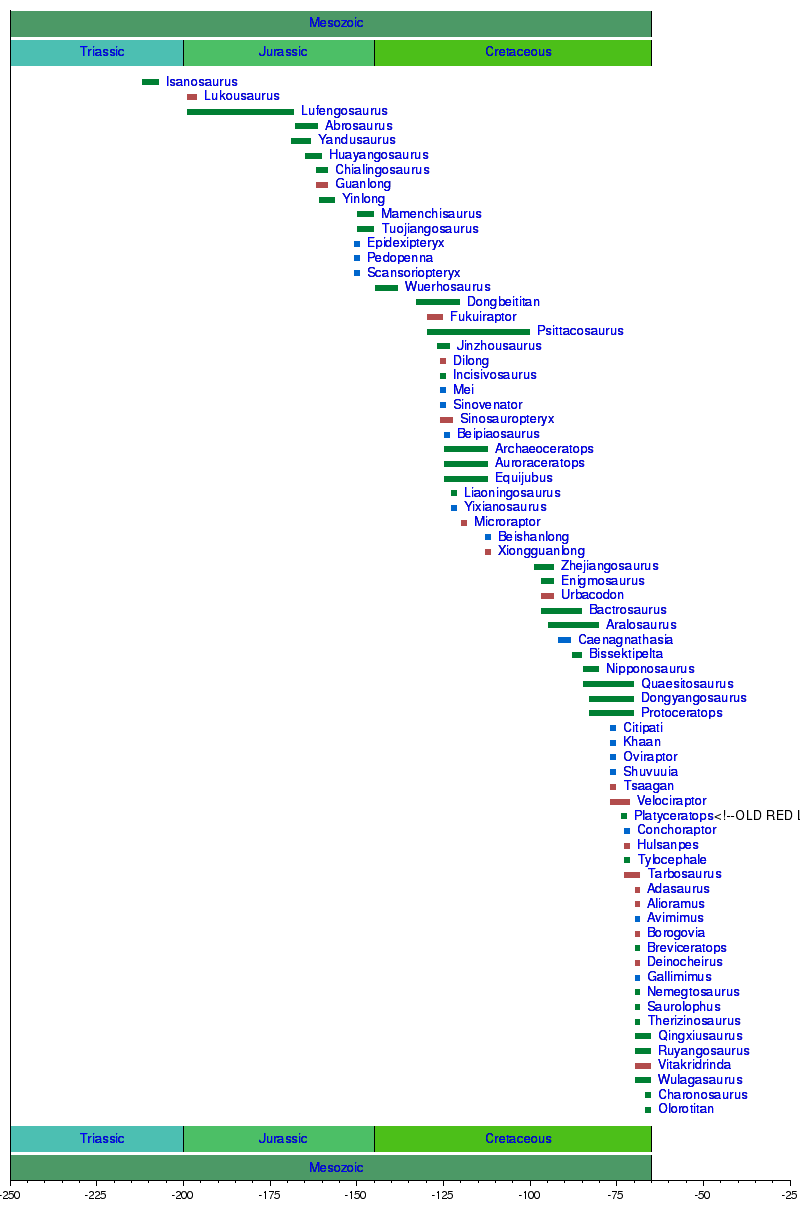
Criteria for inclusion
- The creature must appear on the List of dinosaurs.
- Fossils of the creature must have been found in Asia.
- This list is a complement to Category:Dinosaurs of Asia.

All content from Kiddle encyclopedia articles (including the article images and facts) can be freely used under Attribution-ShareAlike license, unless stated otherwise. Cite this article:
List of Asian dinosaurs Facts for Kids. Kiddle Encyclopedia.


